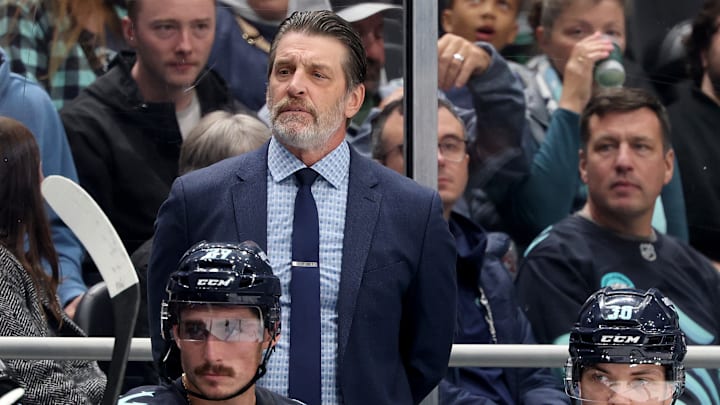One of the biggest changes from last year’s system is how Seattle defends when opponents work the puck behind the goal line. In the past, the first defenseman (D1) would chase behind the net to apply pressure. Now, that responsibility has shifted to the center.
Why does this matter? By keeping both defensemen above the goalie line, Seattle maintains better coverage of the slot and the bumpers. The defensemen can step into lanes on either side of the crease, intercepting passes and denying quick plays into dangerous scoring areas.
The trade-off is that this setup limits the center’s role in breakouts, after all, he’s as deep as a forward can possibly be. The lone exception has been Chandler Stephenson’s line, where Stephenson often floats higher to leverage his speed on transitions, Schwartz takes the center role.
When the puck moves into the corner, the Kraken collapse aggressively. One defenseman shifts to the boards to seal off outlet passes, pinching the puck carrier with help from the center, who then looks for a handoff between the dot and goal line.
The weak-side defenseman stays on the puck side of the crease, covering the slot and ready to intercept passes. The system works when the timing is right. Mistimed reads between the D and center have been responsible for some of the team’s worst defensive breakdowns so far.
Transition Play: Controlled aggression
Breakouts have been much smoother overall. Typically, D1 makes the first pass to the strong-side winger, while the forwards explode up ice.
Because the center starts so deep in the zone, transitions often develop as two-forward rushes. It’s an aggressive style in terms of pace, but the Kraken have been careful with puck management, rarely forcing plays through traffic.
With two defensemen staying back and the center trailing slightly behind the wingers, the Kraken always have lateral options along the boards. It’s a balance between speed and safety, keeping structure even as they attack in waves.
Offensive Zone: Cycling from below the goal line
Offensively, Lambert’s system nearly mirrors the defensive structure. Much of Seattle’s attack starts behind the opposing net.
The puck carrier works below the goal line while the weak-side winger crashes toward the crease for a pass. The strong-side winger trails as a support option, ready to cycle the puck or rotate back.
This constant rotation between wingers and centers keeps defenders guessing. Few teams want to commit extra players below the goal line, and that hesitation creates chaos, defenders have to decide whether to face the puck or the skaters crashing the net.
It also opens up low-to-high play. With skilled defensemen like Brandon Montour capable of making plays in open ice, Lambert’s system thrives on forcing defenders low, then providing attacking chances from up top.
In short, Seattle’s system is a study in structure and disruption, forcing opponents to defend deep, think twice, and chase the puck into uncomfortable spots. It’s not flawless, but it’s undeniably distinct, and it’s giving the Kraken a new identity on both sides of the puck.
